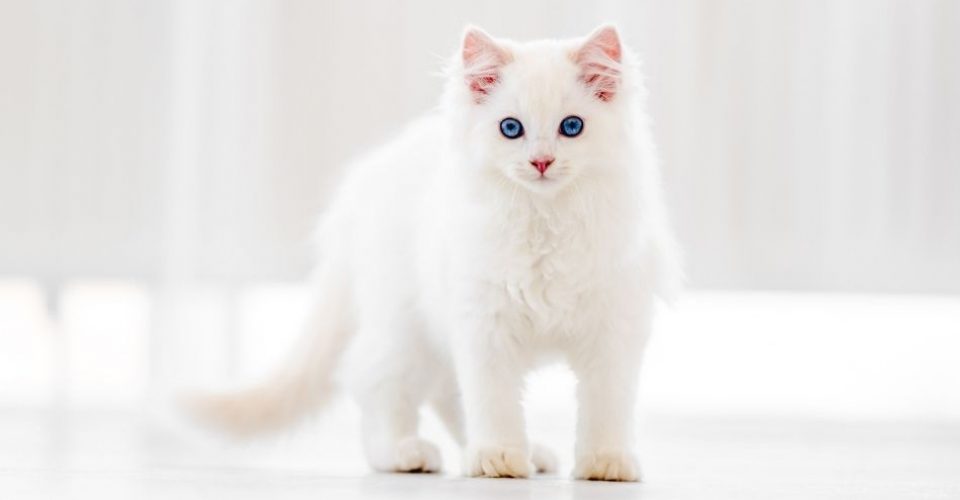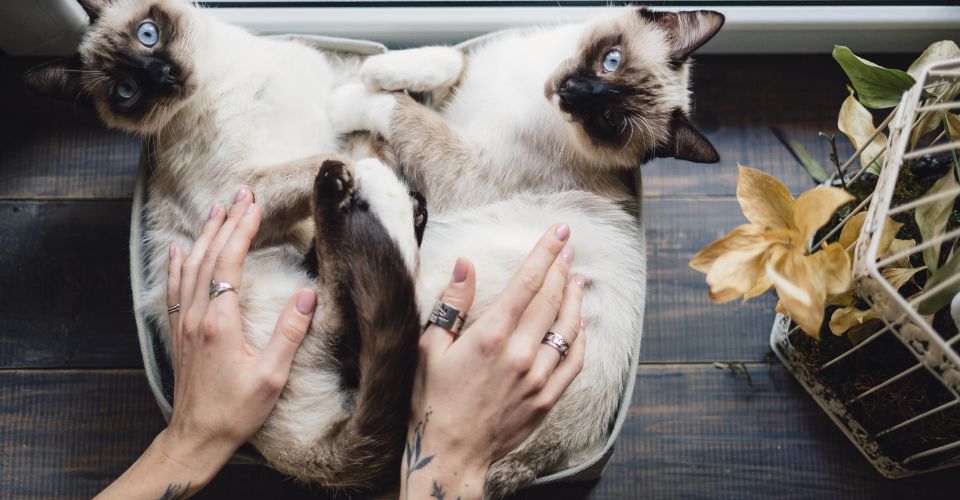Have you been looking for a cuddly, snuggly feline friend—a fluffy cat with a longhaired, super-soft coat? Of course, you are. There is nothing more satisfying than having a fluffy cat lying on your lap and crossing your fingers through her luxurious coat. Want one for yourself?
Below we discuss the seven fluffiest cat breeds for you to adopt from
Fluffy Cat Breeds
With their super soft and silky furry coats, fluffy cats tend to win the hearts of not only feline lovers but also those of “not cat people.” If you want to have a fluffy coat for yourself, go on. But fluffy coats are high-maintenance cats in that they require more grooming than others. More on grooming later. Let’s discuss breeds first.
Fluffy Persian Cat

Key Features
Weight:7 to 12 pounds
Lifespan: 15 to 20 years
Coat Color: Variety of colors divided into seven divisions: solid, solid, and golden, smoke and shaded, tabby, particolor, and bicolor and Himalayan division
Temperament: Sociable, affectionate, calm, and sweet
Suitable for: Families with calm and quiet households
The Persian cats are one of the best-known fluffy cat breeds. It is their longhaired, lustrous coat and easygoing nature that makes Persian cats the most popular cat breed across the United States and the fourth most popular in the world. These Persian beauties come in all sorts of coat color combinations and patterns.
On average, a Persian cat weighs around 7 to 12 pounds and has an average lifespan of 15 to 20 years. That said, the Persian cast are prone to many health issues involving many eye problems and breathing issues. Therefore, Persian cat owners are advised to never skip their annual vet visits and always keep an eye for signs of sickness in cats.
The Persian cat breed is quite easygoing and laidback—they love to laze around in their window perches and nap in their cat beds. They love to snuggle up in the lap of their favorite persons in the house. Persian cats make a perfect fit for calm and quiet households.
Fluffy Maine Coon
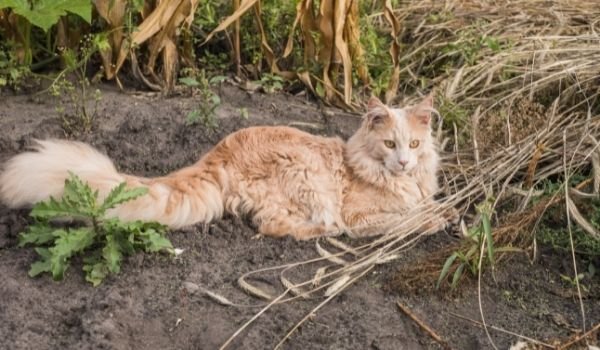
Key Features
Weight:8 to 20 pounds
Lifespan: 12 to 15 years
Coat Color: Variety of color combinations and patterns
Temperament: Loving, affectionate, and sociable good with children and other pets
Suitable for: Multi-cat household, single working adults, and apartment-dwellers
Having originated in Maine, Maine Coon is the only true American cat breed. Next to Persian cat, longhaired Maine Coon is Americans’ second most favorite fluffy cat breed. Known as the gentle giants, Maine Coons have not only a big size and longhaired coats but also a big heart throbbing in their chest. Despite their wild looks, Maine Coons make a great pet, loving and affectionate towards their owners. Among the Maine Coons, White Maine Coon is the rarest and most sought after.
While most cats hate water, Maine Coons are not like most cats—they would instead happily jump in the shower with you. So, while bathing a kitten is a daunting task for most cat parents, it would be a happy hour if you are the parent of a Maine Coon. More so, Maine Coons are neither lackadaisical like Persian cats and nor too energetic like Bengal cats—they are sort of balanced cats.
Maine Coons weigh around 8 to 20 pounds and has an average lifespan of 12 to 15 years. They easily get along with children and other pets, making them great pets for multi-pet households. Given that Maine Coons are even-tempered, they can also be a good choice for single parents and apartment-dwellers.
Norwegian Forest Cat

Key Features
Weight:9 to 16 pounds
Lifespan: 15 to 20 years
Coat Color: All sorts of colors ranging from solid white to coal black except for color points
Temperament: Intelligent, friendly, calm, gentle, and outgoing
Suitable for: Families with children, multiple pet households, Outgoing cat parents
Called Skogkatt in Norway, the Norwegian Forest Cat is a naturally occurring longhaired cat breed. Though the breed was developed in the wilderness without any human involvement, Norwegian Forest Cats make great family pets. They have developed a longhaired coat to cope up with the sunless winters of Norway.
The Norwegian Forest Cat is an overall healthy cat breed with an average lifespan of 15 to 20 years. On average, they weigh around 9 to 16 pounds. The Norwegian Forest cats are curious and playful. They are also said to experience spurts of energy after their naps, so you can expect them to climb on top of doors or bookshelves. If you do not want your Norwegian Forest cat to treat your home like a jungle, the Cat Fanciers’ Association advises you to get them a scratching post and a tall cat tree. This will keep them busy.
SmartCat Pioneer Pet Ultimate Scratching Post

|
The Norwegian Forest cats make a great choice for families with children. They also make an excellent choice for multi-pet households as they lap up the company of other cats or dogs. A Norwegian Forest Cat would also make a perfect companion for outgoing parents as these cats love to go on walks and hikes with their loving parents.
Read: Do Puppies Sleep a Lot?
Fluffy Ragdoll
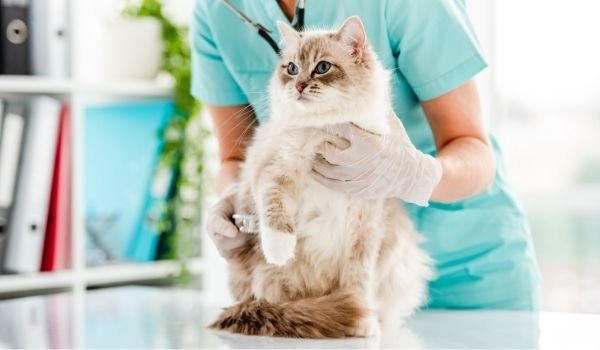
Key Features
Weight:10 to 20 pounds
Lifespan: 13 to 18 years
Coat Color: Seal, blue, chocolate, lilac, red, and cream
Temperament: Bold but highly sociable, loving, and affectionate
Suitable for: Multi-pet house, families with children
Captivating viewers with their blue eyes, Ragdolls are considered semi-longhaired large cats. They have a pointed coat with the color of their face, legs, ears, and tail a bit darker than the rest of their body. Unlike other fluffy cat breeds, Ragdoll cats shed a lot less. This is because they lack a dense undercoat. So if you have been looking for a hypoallergenic cat breed, Ragdoll would make a better choice than other fluffy cat breeds.
Read: Do Puppies Sleep a Lot?
Ragdolls have an average lifespan of 13 to 18 years, and they weigh around 10 to 20 pounds. As compared to other cat breeds, Ragdolls are more interested in their parents and would always run to greet their loving parents at the door. Like dogs, they also love to follow their owners room to room. They also love to sleep on top of their owners.
Siberian Forest Cat
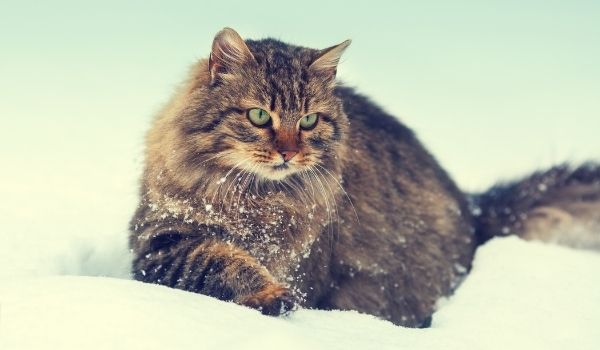
Key Features
Weight:10 to 20 pounds
Lifespan: 10 to 18 years
Coat Color: All colors and combinations
Temperament: Highly affectionate, friendly, and loyal
Suitable for: Families with other pets and children
Hailing from Russia, Siberian Forest Cat, also known as Siberian Cat, is a medium to large cat breed with a medium to long furry and water repellent triple coat. Like Norwegian Forest cats, Siberian Forest cats have developed the thick furry coat to beat the merciless winters of the north.
Siberian Forest Cats are sweet-natured and a bit kittenish in nature. They love to snuggle in bed with their loving owners. They devote all their attention and love to their parents and are very loyal. They do a lot of shedding, so while getting a Siberian Forest cat, you should keep in mind that you will be required to do a lot of grooming and cleaning. According to the CFA, Providing an acceptable scratching space to your Siberian Forest cat is necessary for them to have a healthy and joyful life. So, you may want to check out Smartcat’s scratching post made of wood and fibrous and durable woven sisal.
Siberian cats have an average life expectancy of around 10 to 18 years, and they weigh around 10 to 20 pounds. They make a perfect choice for families with children, seniors, and other pets.
Turkish Van
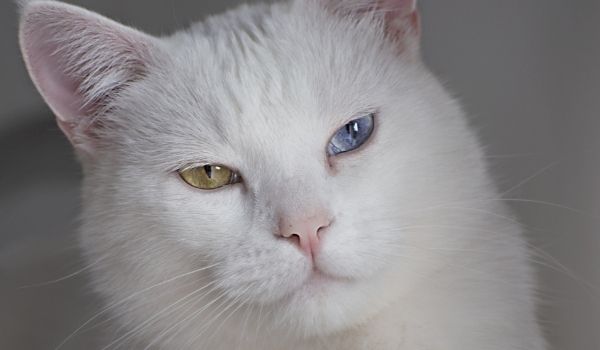
Key Features
Weight:10 to 20 pounds
Lifespan: 13 to 17 years
Coat Color: White color with markings restricted only to their head and tail
Temperament: Highly sociable, playful, and active
Suitable for: Highly active cat parents, families with children
Originating from the mountains of Turkey, the Turkish Van is a naturally occurring cat breed. It is relatively a rare cat breed, popular among cat lovers for its affinity with water. They have often nicknamed “the swimming cat.” If you search cat swimming videos, you are probably going to find the Turkish Van swimming and playing in the water.
The Turkish Vans are highly energetic cats, preferring to run around and jump on top of furniture. Your house is like a jungle to them, where they can climb on top of whatever they can find. If you are tired of your Turkish cat jumping and knocking over things, you can get them a tall cat tree and teach them that climbing on the tree is acceptable but not climbing on the furniture. You can easily train your cat using a clicker. You can also teach your Turkish Van cat how to walk on a leash.
Turkish Van cats have an average lifespan of 13 to 17 years, and their average weight varies between 10 and 20 pounds. They make a great pet for families with children and active cat parents. If you have a pool, you can get a Turkish Van and then enjoy playing and swimming with her in your pool.
Turkish Angora
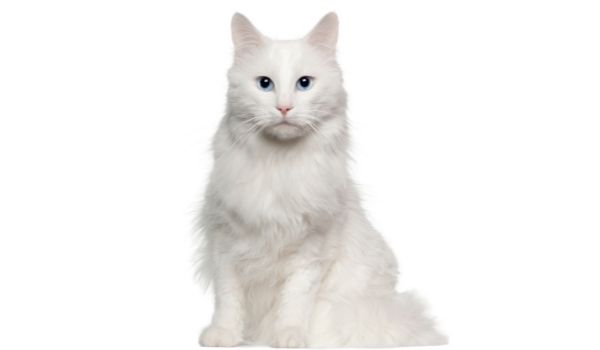
Key Features
Weight:5 to 10 pounds
Lifespan: 13 to 20 years
Coat Color: Variety of colors including solid black, white, and cream; in tortoiseshell; in classic, mackerel and spotted tabbies of many colors; and bi-color
Temperament: Highly sociable, highly adaptable
Suitable for: Families with children, families with other pets, active cat parents
Known for their swimming prowess, Turkish Angora is also a naturally occurring breed. Turkish Angora came to Europe as gifts to European nobility from Turkish Sultans in the early 16th century. The longhaired, soft, silky coat of Turkish Angora is loved by feline lovers across the world. One of the best things about these Turk cats is that their coat rarely mats. Unlike other fluffy cats, these beauties do not need to be brushed every day—once or twice brushing is enough for them to maintain a healthy coat.
That said, during the summertime, the shedding will be more than usual, requiring frequent brushing to avoid the development of hairballs.
Turkish Angoras are highly energetic cats and love to perch up from high places. They love to get on their loving parents and move around. They also love to perch on high places. So, if you are keeping a Turkish Angora, you may want to get a cat window perch and set it up in a high place form where your cat can get a nice view both outside the window and inside the room. These Turkish Cats also love to catch the first ray of sunlight entering the room and pouncing and feathers. So getting a stick and feather cat toy or some other interactive cat toys featuring feathers such as Allstar interactive motion cat toy for your Angora would be great.
Interactive Cat Feather Toys

|
Pop N’ Play Interactive Motion Cat Toy

|
Turkish Angoras are not only extremely intelligent but also highly adaptable, which makes them excellent family pets. They are good with children, strangers, and other pets in the house, but due to their assertive nature, they tend to be the Alpha of the pets in the house.
Fluffy Cat Grooming
Long hair means a lot of shedding—cat hair will be spread all over your house. You while getting a fluffy cat, you should keep in mind that you will have to spend considerable time grooming your fluffy cat. By grooming, you can control the level of shedding in your fluff ball. Below, we have discussed some tips on how to properly take care of a fluffy cat.
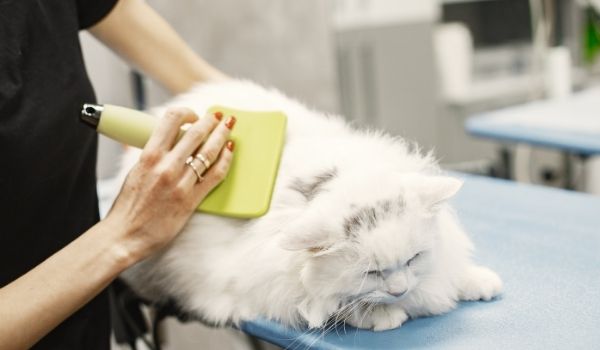
- Regular brushing: keeping a fluffy cat is sort of a part-time job—you will have to brush them daily. Having their coat brushed once a day is imperative, but your fluff ball would appreciate it if you could brush their coat twice a day. Brushing will also tip you off if your cat has any fleas or ticks.
- Have the right brush: There are many cat brushes present in the market, but if you have a fluffy cat, you will have to get a special cat brush with slightly longer and a bit widely spaced pins or bristles. You may want to get a double-sided brush like GoPets’ Professional Double-Sided Pin & Bristle Brush.
- Untangle with great care: Untangling knots on your fluffy cat can be a daunting task. It can also be very painful for your furball; you will have to be extra careful and gentle while untangling these knots. Use a wide-tooth comb, be patient, and do it slowly. If you think it is taking too much time or you just cannot do it, you should take help from a local groomer.
- Trimming the hindquarters: Visiting litter box could soil cat fur around the hindquarters. Therefore, cat owners are advised to keep this area trimmed to reduce the chances of soiling.
- Reward your cat: Grooming sessions could be frustrating for most cats, so if your cat is sitting through the whole session like well-behaved kiddo, you should offer her some tasty cat treats.
Double Sided Pin & Bristle Brush for Dogs & Cats

|
Booda Dome Clean Step Cat Litter Box

|

